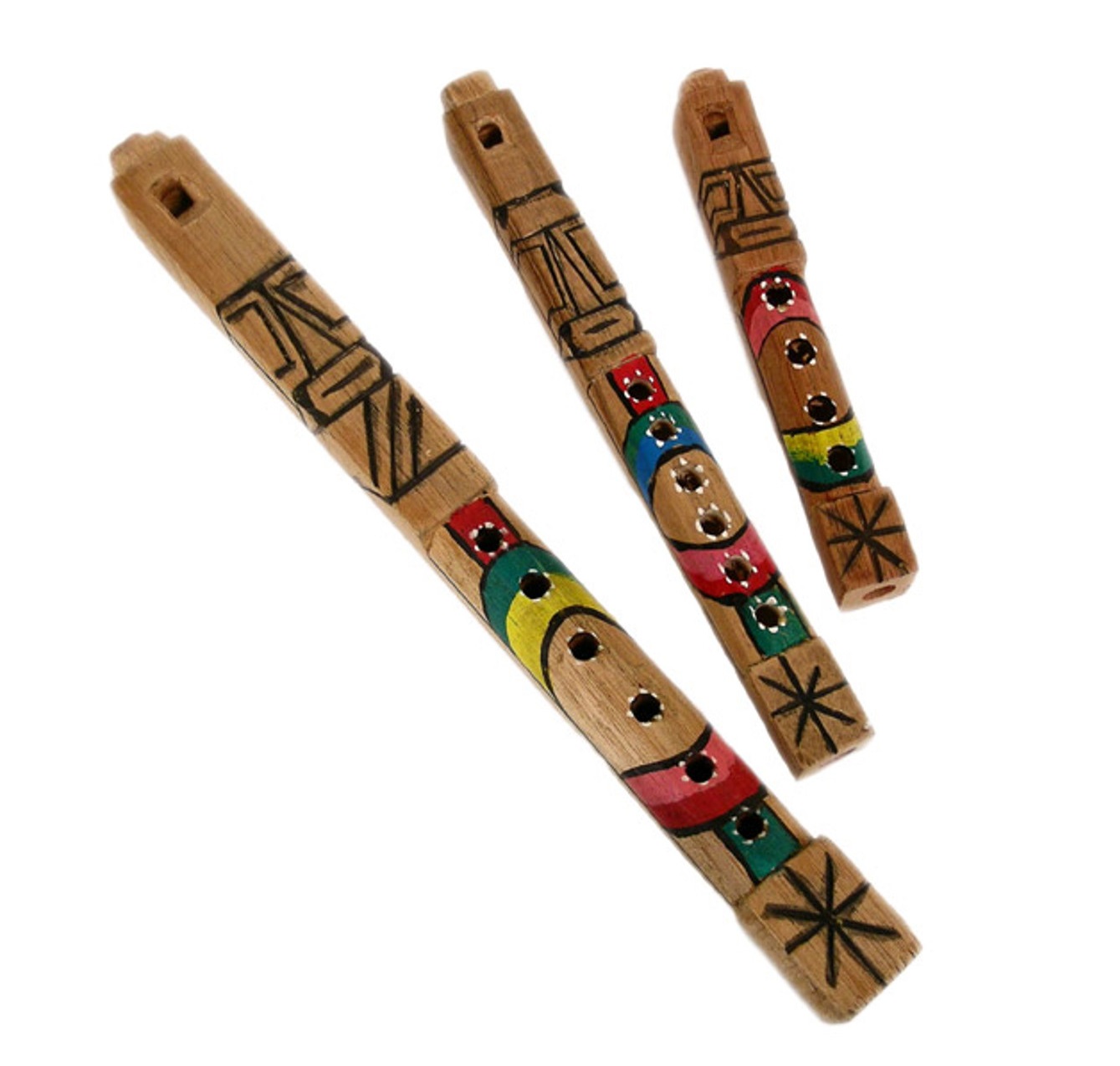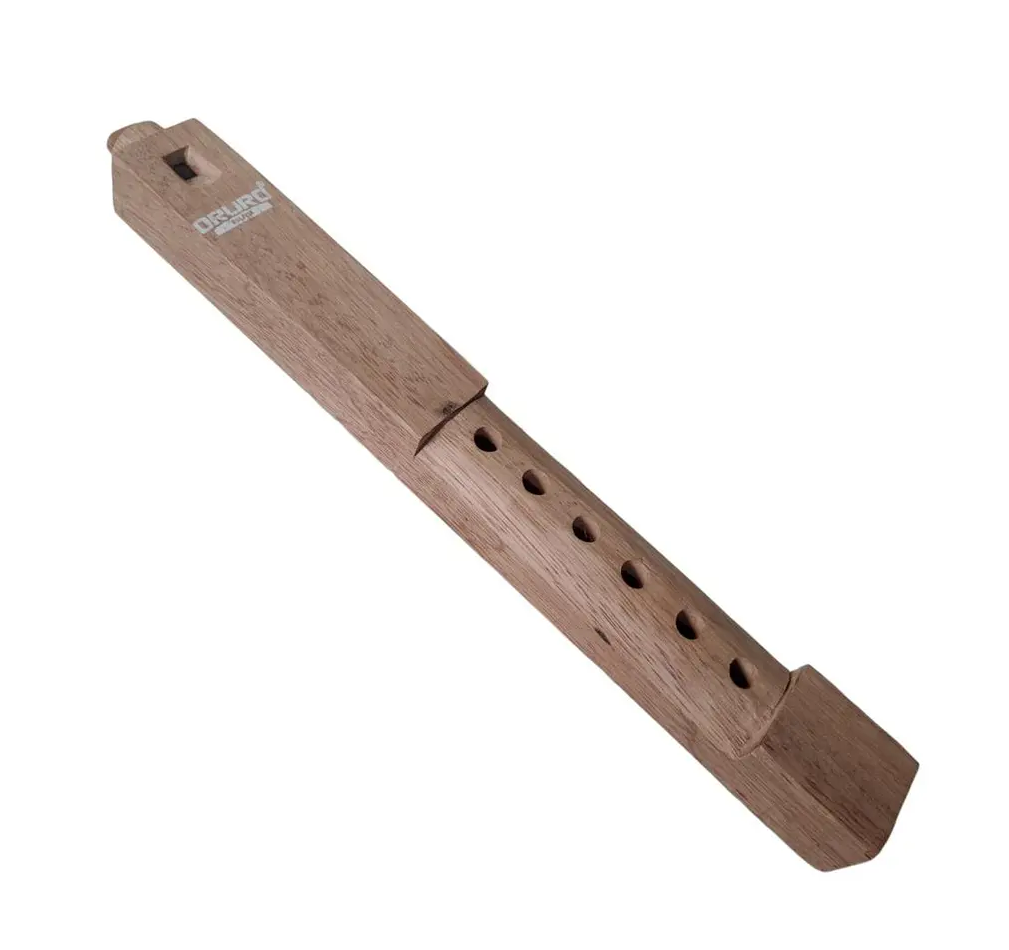Tarka
Woodwinds
America
Unknown
Video
The tarka is a traditional Andean wind instrument, predominantly found in regions such as Bolivia, Peru, and northern Chile. This end-blown duct flute is crafted from a single piece of wood, typically featuring a rectangular or slightly trapezoidal shape. It possesses six finger holes along its body, allowing for melodic variation. The mouthpiece is designed with a block, similar to that of a recorder, facilitating sound production. The tarka’s exterior is often adorned with intricate carvings and vibrant paintings, reflecting the rich artistic traditions of the Andean cultures.
Classified as an aerophone, the tarka belongs to the family of internal duct flutes, akin to the recorder. Its design includes a fipple mechanism at the mouth end, which directs the player’s breath into the instrument to produce sound. The tarka’s relatively short and angular structure distinguishes it from other flutes, contributing to its unique tonal qualities.
The tarka has its origins in the Andean regions of South America, particularly among the Aymara and Quechua-speaking communities. Its exact inception date remains uncertain, but it is believed to have been in use for several centuries, playing a significant role in indigenous musical traditions. The instrument has been integral to various cultural practices, including festivals, ceremonies, and communal gatherings, serving both musical and social functions.
Construction Materials
Traditionally, the tarka is made from a single piece of wood, meticulously carved to achieve its distinctive shape. The choice of wood varies depending on regional availability, but denser woods are often preferred for their durability and resonant qualities. The surface of the tarka is frequently embellished with carvings and painted designs, which not only enhance its aesthetic appeal but also reflect cultural symbols and motifs significant to the Andean people.
Variations
There are three primary sizes of the tarka, each producing a different pitch range:
Licu or Tayca: The largest variant, producing the lowest pitch.
Mala or Malta: The medium-sized tarka, tuned a fifth above the licu.
Ch’illi or Anata: The smallest version, tuned an octave above the licu.
These variations are often played together in ensembles, creating harmonious melodies that are characteristic of Andean music.
Characteristics
The tarka is known for its dark, penetrating sound, which is both rich and resonant. Its angular shape and internal duct design require greater breath control from the player, contributing to its distinctive tonal quality. The instrument’s relatively short length and the placement of its finger holes allow for a range of notes, enabling the performance of both simple melodies and more complex musical pieces.
Sound Production
Sound is produced by blowing into the mouthpiece, where the air stream is directed by the fipple mechanism against the edge of the duct, causing the air within the instrument to vibrate. Covering and uncovering the six finger holes along the body changes the effective length of the air column, thereby altering the pitch. The tarka’s design necessitates a strong and steady breath, and skilled players can modulate their breath to achieve dynamic variations and expressive nuances in their performance.
Playing Techniques
The tarka is typically played in ensembles, with multiple players each handling tarkas of different sizes to create a rich, layered sound. Musicians often employ techniques such as vibrato, achieved by varying breath pressure, and articulation, using the tongue to start and stop notes sharply. The instrument is held vertically, and players use a combination of finger movements and breath control to navigate its melodic range.
Roles in Music
In traditional Andean music, the tarka plays a central role, especially during festivals and communal celebrations. Its powerful, resonant sound makes it ideal for outdoor performances, where it can be heard over large crowds. The tarka often leads melodies, supported by rhythmic accompaniment from percussion instruments such as the tinya (a small drum) and the wankar (a larger drum). The interplay between the different sizes of tarkas in an ensemble creates a harmonious blend that is emblematic of Andean musical aesthetics.
Cultural Significance
Beyond its musical applications, the tarka holds deep cultural significance among the Andean peoples. It is closely associated with agricultural cycles, festivals, and rituals, symbolizing a connection to ancestral traditions and communal identity. The instrument’s distinctive sound is believed to mimic natural elements, such as the wind and the calls of native birds, reinforcing a sense of harmony with the environment. Playing the tarka is often seen as a way to honor the past and maintain the cultural heritage of the Andean communities.
The tarka is a profound embodiment of Andean musical tradition, reflecting the rich cultural tapestry of the region through its unique construction, sound, and the roles it plays in both music and society.
FAQ
What is the Tarka musical instrument?
The Tarka is a traditional Andean wind instrument, similar to a flute, made of wood. It has a rectangular bore and produces a breathy, airy sound. The instrument is often played in festivals and ceremonies in Bolivia and Peru. It is typically performed in ensembles, creating a rich, layered texture.
How is the Tarka played?
The Tarka is played by blowing air into the mouthpiece while covering and uncovering finger holes to change pitch. Players use a distinctive, rhythmic articulation to create a unique sound. It is commonly played in groups, producing harmonized melodies. The playing style varies by region, with different tunings and techniques.
What materials are used to make a Tarka?
The Tarka is traditionally crafted from hardwood, such as jacaranda or mahogany. The wood is carefully carved to create a rectangular bore that influences the tone. Some Tarkas are decorated with intricate carvings or painted designs. The instrument's construction affects its tuning, making each one slightly unique.
 Links
Links
References
Other Instrument
Categories



















